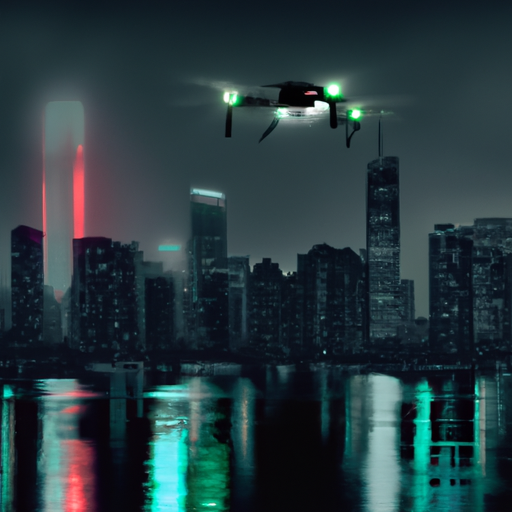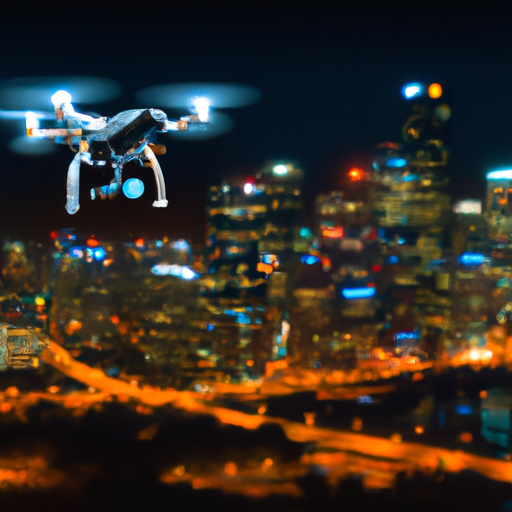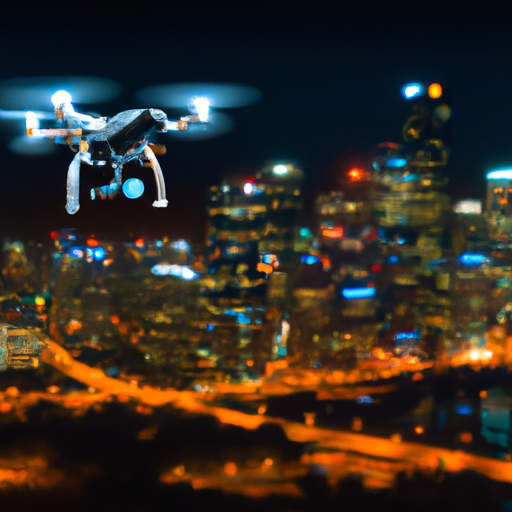Flying a drone at night can be an exhilarating experience, but it also comes with its own unique set of challenges and risks. From ensuring proper visibility to mitigating potential hazards, there are several important factors to consider in order to fly your drone safely after dark. In this article, we will explore some essential tips and guidelines that will help you navigate the nighttime skies with confidence and caution, ensuring both the safety of your drone and those around you.
Understanding the Regulations
Know the local laws and regulations
Before taking your drone out for a night flight, it is crucial to familiarize yourself with the local laws and regulations regarding drone operations. Different countries and jurisdictions may have specific rules in place for flying drones at night. Make sure to thoroughly research and understand these regulations to ensure you are in compliance and avoid any potential legal issues.
Obtain necessary permits and licenses
In addition to knowing the regulations, it is essential to obtain any necessary permits or licenses required for night flights. Some jurisdictions may have specific requirements or restrictions for flying drones at night, such as obtaining a night flight waiver. By obtaining the appropriate permits and licenses, you can ensure that you are operating your drone legally and safely.
Choosing the Right Drone
Consider a drone with built-in lighting
One of the first things to consider when flying a drone at night is its visibility. To enhance visibility, consider choosing a drone that comes with built-in lighting. These lights will make it easier for you to see your drone in the night sky, as well as enhance the visibility for others around you. Look for drones with bright LED lights that can be easily seen from a distance.
Opt for a drone with a long flight time
When flying a drone at night, it’s important to have a drone with a long flight time. Night flights often require more battery power than daytime flights due to the use of additional lighting and the need for longer flight durations to capture specific shots. Investing in a drone with an extended flight time will allow you to fly for longer periods, reducing the risk of your drone running out of battery while in flight.
Ensure the drone has a reliable GPS system
A reliable GPS system is essential when flying a drone at night. It not only helps you with navigation but also provides added safety by allowing you to track your drone’s location accurately. GPS systems help ensure that your drone stays within a specific flight area and enables features such as return-to-home functionality, which can be crucial in case of emergencies. Look for drones with advanced GPS systems to ensure a safer and more controlled night flight experience.

Preparing for Night Flights
Check weather conditions
Before embarking on a night flight, always check the weather conditions. Flying a drone at night brings its own set of challenges, and adverse weather conditions can exacerbate these challenges. Wind, rain, or fog can affect your drone’s stability and visibility, making it unsafe to fly. Ensure that the weather is favorable and suitable for flying before heading out for your night flight adventure.
Charge the drone batteries fully
To avoid unexpected battery failures during night flights, make sure to charge your drone batteries fully before taking off. Night flights often require more battery power due to the use of additional lights and longer flight times. By ensuring your batteries are fully charged, you can enjoy a longer and safer flight without the worry of your drone losing power in the middle of the night sky.
Inspect and maintain the drone
Regular inspections and maintenance of your drone are essential for safe flying, and this holds true for night flights as well. Before taking your drone out for a night flight, thoroughly inspect it for any damages or loose parts. Check the propellers, motors, and other components to ensure everything is in proper working order. This practice will help prevent any mid-flight malfunctions and ensure a smooth and trouble-free operation.
Ensure your remote controller is functioning properly
The remote controller is the lifeline between you and your drone, so it’s crucial to ensure it is functioning properly for night flights. Check the batteries in your remote controller and make sure they are fully charged. Also, check the connectivity between the remote controller and the drone to ensure a strong and reliable connection. It’s a good practice to do a range test before your night flight to ensure that you can maintain control of your drone in low-light conditions.
Enhancing Visibility
Attach high-visibility lights to the drone
Enhancing the visibility of your drone is key to ensuring its safety during night flights. Consider attaching high-visibility lights to your drone to make it more visible in the dark. LED lights that can be easily seen from a distance are a great choice. These lights should be strategically placed on the drone to provide maximum visibility from multiple angles, making it easier for you to track the drone’s movements and ensure its safe operation.
Use reflective tape to improve visibility
In addition to high-visibility lights, using reflective tape on your drone can further improve its visibility at night. Reflective tape reflects light and can make your drone stand out in the dark. Consider placing strips of reflective tape on the body and wings of your drone to enhance its visibility during night flights. The reflective properties of the tape will make your drone more easily visible to both you and others in the vicinity.
Consider using a ground-based lighting system
If you want to take visibility to the next level, consider utilizing a ground-based lighting system. These systems consist of strategically placed lights on the ground that illuminate the drone from below. By using a ground-based lighting system, you can create a beacon-like effect that helps you visually track the position and orientation of your drone even in the darkest night skies. It adds an extra layer of visibility, making your night flights safer and more enjoyable.

Familiarizing Yourself with the Flight Area
Scout the location during the day
Familiarity with the flight area is crucial when flying a drone at night. To ensure a safe and successful night flight, take the time to scout the location during the day. This will help you become familiar with the terrain, potential obstacles, and any specific challenges that may arise. By scouting the location beforehand, you can better plan your flight path and identify any areas that may require extra caution or adjustments for night flights.
Identify potential obstacles and hazards
During your scouting process, pay close attention to potential obstacles and hazards that may pose a risk during night flights. This can include trees, buildings, power lines, or any other structures that could potentially interfere with your drone’s flight path. By identifying these obstacles in advance, you can plan your flight route accordingly and take the necessary precautions to avoid any potential collisions or accidents.
Map out a flight path with specific checkpoints
To ensure a smooth and controlled flight, it is advisable to map out a flight path with specific checkpoints. By planning your flight path in advance, you can have a clear idea of where your drone will be at different stages of the flight. This allows you to anticipate any potential challenges and adjust your flight accordingly. Mapping out a flight path also helps ensure that you stay within the boundaries of your flight area and comply with local regulations.
Importance of Night Flying Skills
Practice flying in low-light conditions
Flying a drone at night requires a different set of skills compared to daytime flying. To ensure you are prepared for night flights, it is crucial to practice flying in low-light conditions. Start by flying in well-lit areas during twilight hours and gradually progress to darker environments. This practice will help you become accustomed to the reduced visibility and develop the necessary skills to control your drone safely at night.
Master controlling the drone’s camera settings
Night flights often involve capturing stunning aerial shots in challenging lighting conditions. To achieve the best results, it is essential to master controlling your drone’s camera settings. Familiarize yourself with the different exposure settings, such as ISO, aperture, and shutter speed, to optimize your camera’s performance in low-light situations. Experiment with different settings to find the right balance between capturing clear and well-exposed images or videos while minimizing noise.
Learn to rely on instrument readings
At night, relying solely on your visual perception may not be enough to control your drone effectively. Learning to rely on instrument readings, such as altitude and speed indicators provided by your drone’s flight controller, becomes crucial. These instrumental readings can provide you with essential information about your drone’s flight parameters, even in low-light conditions. By developing the ability to interpret and utilize these instrument readings, you can ensure a safer and more controlled night flight experience.
Utilizing Safety Features
Enable obstacle avoidance sensors
Many drones come equipped with obstacle avoidance sensors, which can be extremely useful during night flights. These sensors use specialized technology to detect and avoid objects in the drone’s flight path, helping to prevent collisions. Make sure to enable obstacle avoidance sensors on your drone before flying at night. While they are not foolproof, these sensors can provide an additional layer of safety and help mitigate the risks associated with flying in low-light conditions.
Utilize return-to-home function
The return-to-home (RTH) capability is a valuable safety feature offered by most drones. In the event of an emergency or loss of control, activating the RTH function will command your drone to return to its takeoff point automatically. This feature becomes even more important during night flights when visibility may be reduced, and it can be challenging to manually navigate and bring the drone back safely. Familiarize yourself with the RTH function of your drone and ensure it is activated and functioning correctly before embarking on a night flight.
Activate geofencing to prevent straying into restricted areas
Geofencing is a safety feature available in many drones that restricts the flight of the drone within predefined boundaries. This feature can be particularly useful during night flights when it may be harder to visually gauge your drone’s distance from restricted areas. By activating geofencing, you can prevent your drone from straying into restricted airspace, ensuring that you comply with local regulations and avoid potential conflicts with other aircraft or security-sensitive areas.
Maintaining Visual Line of Sight
Ensure you can see the drone at all times
Maintaining visual line of sight (VLOS) with your drone is crucial for safe operations, especially during night flights. It is essential to ensure that you can see your drone at all times and maintain a clear line of sight. It is common for drones to have LED lights that make them highly visible in the dark, but it is still important to keep track of its position and orientation. Avoid flying your drone too far away or behind obstacles that may obstruct your view, as this can increase the risk of accidents or loss of control.
Avoid flying too far or too high
While it can be tempting to push the limits of your drone’s range or altitude during night flights, it is essential to exercise caution. Avoid flying your drone too far away from your position or exceeding the recommended altitude limits. As darkness can affect your depth perception and overall situational awareness, flying too far or too high can lead to loss of orientation and control over the drone. By keeping your drone within reachable distance and within reasonable altitude limits, you can ensure a safer and more enjoyable night flight experience.
Use binoculars or a secondary observer for assistance
If you find it challenging to maintain a clear line of sight with your drone, consider using binoculars or having a secondary observer to assist you. Binoculars can help you see your drone more clearly, especially at greater distances, allowing you to monitor its movements and position more effectively. Alternatively, having a trusted observer who keeps visual contact with the drone can provide you with additional feedback and guidance, enhancing overall safety and situational awareness during night flights.
Avoiding Distractions
Limit distractions such as nearby light sources
Flying a drone at night requires heightened attention and focus. To ensure a safe flight, it is crucial to limit distractions that may affect your ability to control the drone. This includes avoiding flying near bright light sources such as streetlights or floodlights, as they can interfere with your visibility and perception of the drone’s position. Minimizing distractions helps you maintain better control over your drone and reduces the risk of accidents or collisions during night flights.
Focus on the drone’s flight path
When flying a drone at night, it’s easy to get caught up in capturing captivating aerial footage or images. While it’s essential to capture stunning shots, it is equally important to prioritize the drone’s flight path. Stay focused on the drone’s movements and position, ensuring it stays within the planned flight path and avoids any obstacles or hazards. By maintaining a strong focus on the drone’s flight path, you can ensure a safer and more controlled night flight experience.
Avoid flying in crowded areas
To mitigate potential risks and ensure the safety of yourself and others, it is advisable to avoid flying your drone in crowded areas at night. While it may be tempting to capture footage in bustling city centers or popular events, the presence of a large number of people can increase the likelihood of accidents or collisions. Choose flight areas that are less populated or have minimal foot traffic to minimize the risks associated with flying a drone at night.
Safety Measures for Emergency Situations
Prepare for battery failure or loss of signal
Even with thorough preparation and precautions, emergencies can still happen during night flights. It is essential to be prepared for potential emergencies, such as battery failure or loss of signal. Keep track of your drone’s battery level and ensure you have enough remaining power to execute a safe landing. In case of a sudden loss of signal, stay calm and activate the RTH function to initiate an automated return. Being prepared for emergencies can help you handle unexpected situations during night flights and increase the chances of a successful outcome.
Know how to initiate an emergency landing
In the event of an emergency during a night flight, it is crucial to know how to initiate an emergency landing. Familiarize yourself with the emergency landing procedures specific to your drone model. This may involve manually controlling the drone’s descent or activating emergency landing modes that your drone may offer. Understanding and practicing these emergency landing procedures beforehand will ensure that you can respond quickly and effectively in case of an emergency.
Have a plan to retrieve the drone if it crashes
Despite all precautions, accidents can still occur, and your drone may crash during a night flight. It is essential to have a plan in place for retrieving your drone safely after a crash. Prepare a flashlight and other necessary tools to aid in the retrieval process. Be cautious while using the flashlight, as it can disturb nearby residents or create distractions. By having a retrieval plan in place, you can minimize the risk of losing your drone or damaging it further and ensure a quick and safe recovery.
In conclusion, flying a drone at night can be an exciting and rewarding experience, but it requires meticulous planning, preparation, and adherence to safety guidelines. Understanding the local regulations, choosing the right drone, preparing for night flights, enhancing visibility, familiarizing yourself with the flight area, and developing night flying skills are all essential steps to ensure a safe and enjoyable night flight experience. By utilizing safety features, maintaining visual line of sight, avoiding distractions, and being prepared for emergency situations, you can mitigate risks and fly your drone at night safely. Remember to always prioritize safety and be a responsible drone pilot to protect yourself, others, and the airspace.



